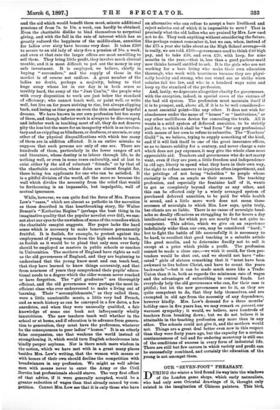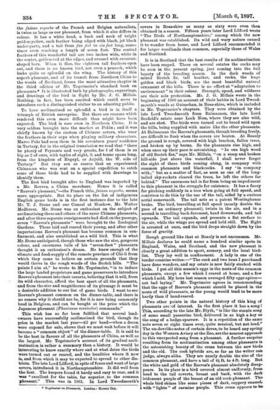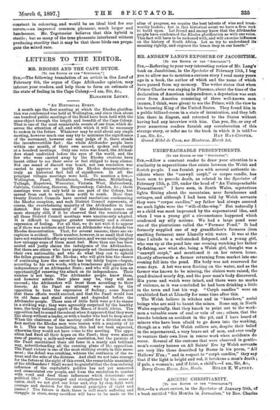OUR "SEVEN-FOOT " PHEASANT.
DURING the winter a bird found its way into the windows of the London game shops, which early naturalists, who had only seen Oriental drawings of it, thought only existed in the imagination of Chinese painters. This bird, the faisan superbe of the French and Belgian naturalists, is twice as large as our pheasant, from which it also differs in colour. It has a white head, a back and neck of bright golden-yellow, each feather being edged with black, jet black under-parts, and a tail from five feet to six feet long, some- times even reaching a length of seven feet. The central feathers of this wonderful tail are two inches wide, white in the centre, golden-red at the edges, and crossed with crescent- shaped bars. When it flies, the eighteen tail feathers open out, and there is no known bird, not even a peacock, which looks quite so splendid on the wing. The history of this superb pheasant, and of its transit from Northern China to the woods of Scotland, forms the most attractive chapter in the third edition of Mr. Tegetmeier's standard book on pheasants.* It is illustrated both by photographs, engravings, and drawings of the bird in flight by Mr. J. G. Millais. Nothing,- in fact, has been omitted which could serve to introduce such a distinguished visitor to an admiring public.
To have acclimatised so splendid a bird is in itself a triumph of British enterprise. But there are reasons which rendered this even more difficult than might have been expected. The bird is rare even in Northern China. It is very seldom brought into the market at Pekin ; and it was chiefly known by the custom of Chinese actors, who wear the feathers in their caps when playing military characters. Marco Polo had seen them in his seventeen years' residence in Tartary, for in the original translation we read that "there be plenty of Feysants and very greate, for 1 of them is as big as 2 of ours, with tayles of eight, 9, and tenne spans long, from the kingdom of Erguyl, or Arjuill, the W. side of Tartary." But they are so scarce that an experienced Chinaman who was sent on a special expedition to catch some of these birds had to be supplied with drawings to identify them.
The first bird brought alive to England was imported by a Mr. Reeves, a China merchant. Hence it is called " Reeves's pheasant,"—the French title, faisan superbe, seems more appropriate. But its place on the list of indigenous English game birds is in the first instance due to the late Mr. T. J. Stone and our Consul at Hankow, Mr. Walter Medhnrst. Mr. Stone was an enthusiast on the subject of acclimatising these and others of the rarer Chinese pheasants, and after three separate consignments had died on the passage, seven " Reeves's pheasants" were brought to the Zoological Gardens. These laid and reared their young, and after other importations Reeves's pheasant has become common in con- finement, and also established as a wild bird. This is what Mr. Stone anticipated, though those who saw the size, gorgeous colour, and enormous tails of his " seven-foot " pheasants thought it an enthusiast's dream. He knew enough of the climate and food-supply of the remote province of Chi-li from which they came to believe on certain grounds that they would thrive in the rough woods of the Scotch hills. " The points I aim at," he wrote to Mr. Tegetmeier, " is to induce the large landed proprietors and game preservers to introduce Reeves's pheasant into their coverts, believing that it will, from its wild character, afford the best sport of all the pheasants, and from the size and magnificence of its plumage it must be a desirable addition to our list of game birds. I want to see Reeves's pheasant common on the dinner-table, and there is no reason why it should not be, for it is now being commonly bred in Belgium, and can be bought at the price which the Japanese pheasant (Phasianus versicolor) commands."
This wish has so far been fulfilled that several land- owners have successfully acclimatised the bird, though its price in the market last year—E2 per head—when a dozen were exposed for sale, shows that we must wait before it will become a " common object " of the dinner-table. It is said to be the best in flavour of all the pheasants of China, as well as the largest. Mr. Tegetmeier's account of its gradual accli- matisation is rather a summary than a history. It would be interesting to know exactly where and at what dates the birds were turned out or reared, and the localities where it now is, and from which it may be expected to spread to other dis- tricts. The late Lord Lilford, in spite of foxes and want of large covers, introduced it in Northamptonshire. It did well from the first. The keepers found it hardy and easy to rear, and it was " excellent for the table, far superior „to the common pheasant." This was in 1881. In Lord Tweedmonth's e Tegetmeier on Pheasant. Lohdon : Hornoi cot. covers in Ross-shire as many as sixty were even then obtained in a season. Fifteen years later Lord Lilford wrote "The Birds of Northamptonshire," among which the new pheasant was established. Its wild and wary nature caused it to wander from home, and Lord Lilford recommended it, for larger woodlands than common, especially those of Wales and Scotland.
It is in Scotland that the best results of its acclimatisation have been reaped. There on several estates the cocks may be seen in the present spring, just coming into the full beauty of the breeding season. In the dark woods of mixed Scotch fir, tall heather, and rocks, the huge golden and black birds. are the most beautiful natural ornament of the hills. There is no effort at "adaptation to environment" in their colour. Strength, speed, and wildness are their sole protection. Mr. J. G. Millais wrote in the beginning of 1896 an account of their habits in Lord Tweed- mouth's woods at Guisachan, in Ross-shire, which is included in Mr. Tegetmeier's chapters. They were obtained by the late Lord Tweedmouth from Balmacaan, the late Lord Seafield's estate near Loch Ness, where they are also wild, and are shot. The birds were turned out to breed wild upon the hills, being supplied with maize like the other pheasants. At Balmacaan the Reeves's pheasants, though breeding freely, are difficult to flush when the covers are beaten. At Beauly the ground is rough, covered with high bracken, fallen trees, and broken up by burns. So the pheasants rise high, and when once up their pace is astonishing. " In one high wood of old Scotch firs," says Mr. Millais, " on a steep and broken hill-side just above the waterfall, I shall never forget the sight of these birds coming along, in company with common pheasants and blackcocks. I say ' in company with ; ' but as a matter of fact, as soon as one of the long- tailed sky-rockets cleared the trees, he left the others far behind." The enormous tail is far from being an impediment to this pheasant in the struggle for existence. It has a fancy for pitching suddenly in a tree when going at full speed, and contrives to do this by the use of the tail, aided by a curious aerial somersault. The tail acts as a patent Westinghouse brake. The bird, travelling at fall speed (nearly double the pace of an ordinary pheasant), twists in the air, and in a second is travelling back-foremost, head downwards, and tail upwards. The tail expands, and presents a flat surface to the air, while the wings are spread and held still. The flight is arrested at once, and the bird drops straight down by the force of gravity.
Rough ground like that at Beauly is not uncommon. Mr. Millais declares he could name a hundred similar spots in England, Wales, and Scotland, and the new pheasant is clearly a great addition to sport, scenery, and the local bird- list. They lay well in confinement. A lady in one of the border counties writes:—" The cock and two hens I purchased have done wonders, and my estate is now fairly stocked with birds. I put all this season's eggs in the nests of the common pheasants, except a few which I reared at home, and a few which I sold. My hens last season averaged fifty eggs apiece— not bad laying." Mr. Tegetmeier agrees in recommending that the eggs of Reeves's pheasant should be placed in the nests of wild pheasants, as the young would tend to be more hardy than if hand-reared.
Two other points in the natural history of this king of pheasants are' of interest. In the first place it has a song This, according to the late Mr. Blyth, "is like the simple song of some small passerine bird, delivered in as high a key as the song of a hedge-sparrow. It is a repetition of the same note seven or eight times over, quite musical, but not loud." The nn-dovelike notes of certain doves, to be heard any spring day in the Western Aviary at the Zoo, are the nearest approach to this unexpected song from a pheasant. A further surprise resulting from its acclimatisation among other pheasants is the astonishing beauty of the cross between the new birds and the old. The cock hybrids are, so far as the writer cam judge, always alike. They are nearly double the size of the common pheasant, and have a tail of 41 ft. to 4 ft. long. But the white and gold of the Reeves's pheasant absolutely disap- pears. In its place is a bird covered almost uniformly, from head to the tail coverts, breast and back, with the dark iridescent purple of the breast of an old cock-pheasant. The whole bird shines like some pieces of dark, coppery enamel, with " lights " of carmine purple. This cross appears to be
constant in colouring, and would be an ideal bird for our covers,—an improved common pheasant, much larger and handsomer. Mr. Tegetmeier believes that this hybrid is sterile ; but so many of the true pheasants interbreed without producing sterility that it may be that these birds can propa- gate the mixed race.








































 Previous page
Previous page